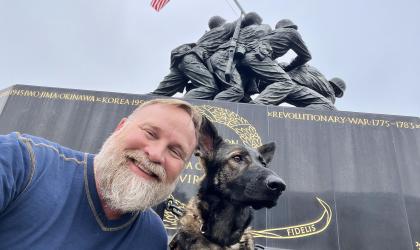September 2024
Fall is here. Out with the swim suits and in with the heavy sweaters. Something that isn’t seasonal? Security—local, national, and global.
We view security from every angle and by every measure. It’s foundational to our R&D philosophy.
Think: defense readiness, secure supply chains, resilient transportation networks, first responder preparedness, safe AI-enabled systems, a strong health ecosystem, U.S. competitiveness. And much more.
Bottom line: We’re in the service of security, on all fronts, always.
8-minute read time
OUR CULTURE IN ACTION
An Ongoing Journey to Healing
It’s been 23 years since our nation mourned—and united—following the terrorist attacks of September 11. From their perspective on the ground at the Pentagon, five of our people reflect on that day and the days that followed.
Each worked in a different capacity on 9/11 and ultimately found their way to MITRE. All five say the experience cemented their commitment to national security and the public good.
WHO'S NEXT
Flight Path

Aerospace engineer Marco Quezada’s experience building flight simulators brought him to MITRE 16 years ago. Today, he’s the technical bridge between our Integrated Demonstration and Experimentation for Aeronautics (IDEA) Laboratory in McLean, Va., and its twin lab in Southeast Asia, known as MAPS, MITRE Asia Pacific Singapore. His work helps advance airspace harmonization around the world. It’s intense, and he wouldn’t have it any other way.
Quezada, who was born in Mexico and loves the travel aspect of his work, says, “I have a great team, and we’ve set a high bar for excellence. Even when the pressure is on—we’ll accomplish our goal.”
THE BIG PICTURE
Fight- and Flight-Ready

When protecting U.S. interests in conflicts globally, one thing’s certain: High-tech weaponry won’t make a bit of difference if we can’t get to—and stay in—the fight.
The problem: Circumstances change quickly. U.S. Air Force personnel could spend hours a day creating aircraft schedules, only to be overcome by events requiring more time to course correct.
The solution: With the USAF, we created a human-machine teaming tool to automate scheduling in just minutes. The Field-Level Aircraft Scheduler, better known as FLASH, helps optimize planning for a range of aircraft types and scheduling variables.
The bottom-line: The capability enables the Air Force to rapidly adapt “on the fly”—ensuring aircraft are mission-ready.
By the way: A FLASH-like system could prove useful for other military planning and logistics, such as ground-based systems, seaborne platforms, and more.
PIN DROP
Happy Birthday, U.S. Air Force!

The USAF, our first government sponsor, marked 77 years of service on September 18.
Just 10 years younger, we got our start helping develop the service’s Semi-Automatic Ground Environment (SAGE), a key component of Cold War-era air defense and later the National Airspace System.
Our technical contributions as chief systems engineer for the USAF’s Airborne Warning and Command and Control System (AWACS) helped create a game-changing capability for U.S. and NATO forces.
We continue advancing the Air Force’s mission through our work in the National Security Engineering Center, the federally funded R&D center we operate for the Defense Department.
BEHIND-THE-SCENES SECURITY
An All-angles View

Rocking out: While 23,000+ fans enjoyed (Travis) Kelce Jam 2024, the Kansas City region’s largest music festival, a small MITRE team worked security. That is, we demonstrated a prototype technology that gives law enforcement and first responders a common picture of an event.
Ahead of the festival, the Kansas Department of Transportation asked us to develop KNET—short for Kansas Network of Emerging Technologies.
What is it? “…a platform that can reliably share data with all relevant emergency responders in near-real-time—packaged in an easy-to-digest view,” says KNET MITRE project leader Trever Linn.
KNET disseminates uncrewed aircraft system (UAS) video to first responders, sharing UAS and first-responder-location information and distilling incident data into a shared operating picture. Other feeds—like traffic cameras—can be integrated.
The goal: Better-informed emergency response, enhanced interagency coordination, and elevated public safety at large gatherings.
What did KNET “see?” More than 30 incidents, including medical emergencies, unruly patrons, and a fence-jumper. With all stakeholders sharing a singular, simultaneous view.
What’s next? Possibly expanding on this work for federal agencies. “It’s a key part of MITRE's mission to build upon work for one government sponsor to serve the needs of another in the public interest,” says Michael Guterres, Ph.D., who leads MITRE's portfolio on advanced aviation.
DOGS IN SERVICE
Helping and Healing

Our employees and their families are helping to lead the pack in raising awareness about PTSD service dogs—through puppy-raising, volunteering, and more. The personal, emotional, and physical security the dogs provide can be transformative./a>.
“Having a service dog has in so many ways opened up the world for my spouse—and therefore our family,” says Dagmara Shepard, MITRE director of engagement, program management, and communications, of German Shepherd Claymore.
WE’RE HIRING

Join our talent community of innovators, learners, knowledge-sharers, and risk-takers. Check out opportunities to amplify your impact for public good.
